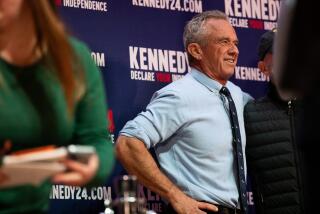‘Dot-Coms’ Looking for a Big Score
- Share via
Cat food, computers and cars aren’t the only things that “dot-com” advertisers will be pitching during ABC’s Super Bowl Sunday broadcast from Atlanta. Cash-rich online companies also will use the pricey commercial breaks to woo investors with dreams of stepping into the fast-paced world of online commerce.
Long the province of such well-known marketers as Visa, Pepsi-Cola and Anheuser-Busch, Super Bowl advertising is being reshaped by more than a dozen dot-coms that have paid a cumulative $25 million to reach the 130 million Americans who will be watching Super Bowl XXXIV.
Using the highly watched broadcast to spark interest among potential investors “is a pretty astute strategy,” said Dan Burke, a senior analyst who tracks online trading for Lincoln, Mass.-based Gomez Advisors. “There’s definitely some form of legitimacy that comes with advertising on the Super Bowl because people know how much it costs . . . there’s an opportunity here to build brand and investor awareness.”
Dot-coms will pay dearly for the opportunity. Driven in large part by dot-com demand, ABC--which asked for the money upfront--is charging a record $2 million for 30-second commercials aired during the game, which matches the Tennessee Titans and the St. Louis Rams.
The Super Bowl strategy is a leap of faith for such companies as Computer.com, which will use two pregame spots and a fourth-quarter commercial to kick off its Web site. “People keep asking if spending this much money is crazy,” said Mike Zapolin, chief executive of Maynard, Mass.-based Computer.com, a privately held start-up that is spending $3 million on Super Bowl spots. “But just look at the audience we’ll draw--every Internet executive out there, every Internet entrepreneur . . . our future shareholders, people who are interested in dot-com stocks.”
Computer.com hopes to match the success that Monster.com had last year with quirky black-and-white commercials that showed youngsters sharing such career aspirations as clawing their way into middle management. Traffic to Monster.com’s Web site rose 450% on the strength of the ads. Zapolin says he’s “sleeping great at night” despite the hefty investment because the Monster.com ad executive who dreamed up last year’s campaign sits on the Computer.com board.
Dot-com executives are angling for “mental shelf space, to get on the minds of people,” said Harvard University professor Stephen A. Greyser, who tracks sports and consumer marketing trends. “Some of these companies are there to try and get the number of ‘hits’ on the Web sites to increase. But it’s clear to me that many of these dot-coms are looking for a big lift in visibility in the financial world.”
New York ad-agency executive Mark DiMossimo doubts that the Super Bowl will deliver for many of the dot-coms. But he understands what’s driving them: “They’re trying to reach possible strategic partners--the smart money, people who make IPOs possible. And many think going big with the Super Bowl just might do it.”
Dot-coms also are using commercial breaks to send a business-to-business message.
Romac International, a Tampa, Fla.-based staffing company, is using four ads on Sunday to introduce its kforce.com Web site. Chief Marketing Officer Ken Pierce is betting that the Super Bowl connection will click with consumers on the prowl for new jobs--as well as executives with the power to hire.
AutoTrader.com’s third-quarter spot, which shows the online service helping a consumer navigate the frustrating process of buying a used car, is designed to help the print publication speed its transition to online player. The ad is aimed at consumers who need transportation and dealers who have cars and trucks to sell. “The Super Bowl is a big deal for us because it allows us to talk to both of our main audiences,” said President and Chief Executive Chip Perry.
The brick-and-mortar marketing world long has recognized the message that a successful Super Bowl commercial can send to consumers and potential business partners. “It can be a morale builder for the corporate staff and a way to open doors for the sales force,” said Keith Bruce, the San Francisco-based director of sports marketing for ad agency Foote, Cone & Belding.
The advertising industry is reverberating from a rush of dot-com advertising dollars. Spending patterns suggest that dot-coms budgeted at least $1.2 billion for advertising last year, according to Competitive Media Reporting. The advertising storm culminated in the fourth quarter, when e-tail Web sites inundated consumers with edgy ads.
The now-or-never atmosphere in the online world is being exacerbated by the pressure-cooker atmosphere created by the Super Bowl. A spot that might light up the screen on Tuesday night might look shopworn if it can’t compete with, say, 20th Century Fox’s commercial for “Titan A.E.,” a next-generation animated film that opens in June.
Forrester Research Inc. analyst Charlene Li cautions that, to be effective, dot-coms must produce advertisements that “convey more than image” and extend well beyond Sunday. While dot-coms are spending more on advertising than they’ll ring up in yearly profit, their advertising expenditures pale alongside Anheuser-Busch, which last year spent $18.6 million to superimpose lizard and Clydesdale tracks across the Super Bowl telecast.
“The competitive clutter right now is very, very high, so the challenge from a marketing perspective is breaking through with a distinct message that will be remembered,” said John Herr, vice president of advertising and marketing for Aliso Viejo-based Buy.com, which bought regional Super Bowl ads last year but won’t advertise on Sunday because of the potential for a dot-com logjam.
Edgy humor that defines dot-com advertising might also create problems. Edgy is fine, ad experts agree, but over-the-edge spots could backfire.
“It’s not so much as whether the spot is offensive as whether it can be perceived as being offensive,” Greyser said. “The negative public relations that comes after the fact can be huge.”
The dot-com advertising traffic jam prompted some cash-rich online competitors to ignore Sunday’s broadcast. DLJ Direct, the online trading arm of Donaldson Lufkin & Jenrette, earlier this week aired a spot that pokes fun at competitors willing to pay $2 million for a 30-second spot.
Homestore.com, which offers home and real estate information, opted not to advertise during the recent e-tailing blitz or the Super Bowl. The Thousand Oaks company instead introduced its advertising campaign in January. “We think many people were dot-commed out,” said Jeff Charney, Homestore’s senior vice president of marketing. “We thought advertising would be wasted in the fourth quarter of 1999--much less the fourth quarter of the Super Bowl.”
Who’s still watching during the fourth quarter isn’t idle speculation for Atlanta-based LastMinuteTravel.com, which specializes in travel arrangements. The late-in-the-game advertising strategy plays upon the company’s name, but the commercial’s impact could depend upon whether the game is close enough to keep fans from tuning out.
Last year, second-half advertisers cringed as the Denver Broncos pulled away to an early lead over the Atlanta Falcons. Super Bowl XXXIII finished with the second-lowest ratings of the 1990s.
(BEGIN TEXT OF INFOBOX / INFOGRAPHIC)
Super Rates
Super Bowl advertising expenditures and ad rates have more than doubled over the past decade.
More to Read
Inside the business of entertainment
The Wide Shot brings you news, analysis and insights on everything from streaming wars to production — and what it all means for the future.
You may occasionally receive promotional content from the Los Angeles Times.










